Telling the Story Generation to Generation
The A-bomb Dome miraculously escaped destruction despite its location just 160 meters from the hypocenter. As for whether the wreckage should be preserved as a memorial or be demolished, residents’ opinions have been divided from the beginning. When more than ten years had passed after the A-bombing, the pros and cons on preservation of the A-bomb Dome, with destruction hanging over it by a thread, were divided in a full-scale debate.
After it was decided to preserve the dome, the course of developing fundraising for the preservation project into a nationwide peace movement gave people opportunities to think about the meaning of conveying the tragedy of the A-bombing and the courage to act. Disputes over preservation of the A-bomb Dome also meant controversy over handing down the A-bomb experience.
Preservation of A-bombed Materials
In 1949, the A-bomb Reference Material Display Room was established in a corner of the Chuo Community Hall in Moto-machi. The Atomic Bomb Memorial Hall was later constructed adjacent to the Community Hall. Shogo Nagaoka, who was engaged in collecting materials and conducting research on them, accepted the opportunity to be the first director of the Hiroshima Peace Memorial Museum, which opened in 1955. Relatively few materials were available at the opening, but the museum subsequently received numerous donations.
 |
 |
 |
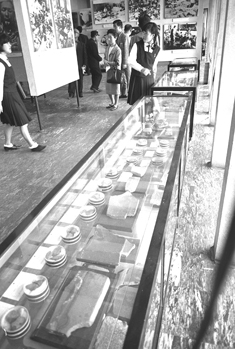
Exhibition in the early days
1967 Nakajima-cho
A-bombed roof tiles and stones are exhibited in a glass case. After the facility was opened, the exhibits were increased with further donations from citizens of articles from their deceased family members.
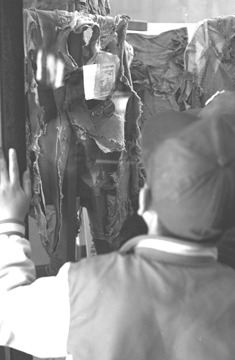
A boy looking at clothes
1970 Nakajima-cho
This boy is looking at an exhibit of clothes that are the same size as his. What did he feel when he saw these scorched clothes?
|
 |
Monroe and DiMaggio
visiting the Atomic Bomb Memorial Hall
February 9, 1954 Moto-machi
Marilyn Monroe and Joe DiMaggio visited the Atomic Bomb Memorial Hall adjacent to the Chuo Community Hall during their honeymoon in 1954. They looked at exhibits such as a panoramic model of Hiroshima City after the A-bombing and A-bombed roof tiles.
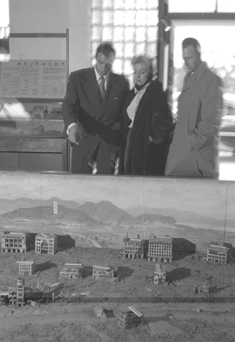
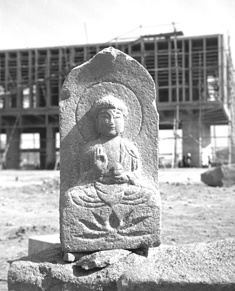
Commencement of the construction of the Peace Memorial Museum
1951 Nakajima-cho
In February 1951, construction of the Peace Memorial Museum was commenced. At the place where there once was a temple and a graveyard, only a small stone image of the Buddha was left.
|
Preservation of the A-bomb Dome
In 1965, full-scale research to protect the deteriorated A-bomb Dome was begun. In 1966, the Hiroshima City Council unanimously decided to preserve the Dome, and a fundraising campaign for the preservation project was initiated. Numerous pledges, totaling 66 million yen, were raised from Japan and overseas, surpassing the target amount of 40 million yen. The first preservation project was completed in 1967. A second preservation project was completed in 1990 and a third preservation project in March 2003.
 |
 |
 |
 |
 |
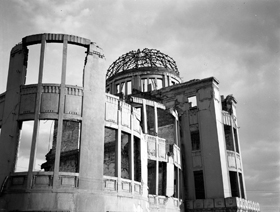
Leaning wall due to the blast
1950 Ote-machi 1-chome
The A-bomb Dome’s west wall, leaning due to blast pressure. In the first preservation project, returning this wall to its former perpendicular position was the most difficult operation.
|
|
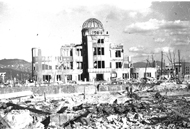
A-bomb Dome immediately after the bombing
1945
Sarugaku-cho
(now, Ote-machi 1-chome)
The A-bomb Dome, seen from the bank on the other side of the Motoyasugawa River immediately after the bombing. Rubble from broken walls and stone pillars was piled up in the area around the A-bomb Dome.
|
 |
 |
 |
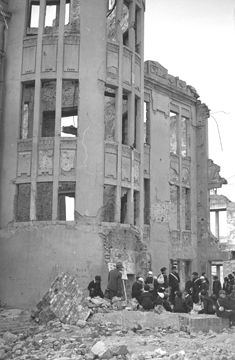 |
 |
Students on a school excursion taking a tour(Left)
1952 Ote-machi 1-chome
Visitors used to be able to enter the compound. Since the A-bomb Dome had, with the passing of time, reached a dangerous condition with repeated small-scale collapses, it has been off limits since 1962, with wire netting surrounding it to prevent entry.
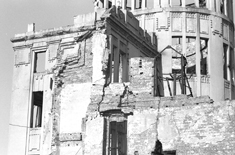
Weathering of A-bomb Dome
1965 Ote-machi 1-chome
The A-bomb Dome came to be in a dangerous state, with cracks spreading in the walls. In 1965, Hiroshima City asked the Architecture Department in the Engineering School of Hiroshima University to conduct a thorough inspection of the building’s structural condition.
|
 |
 |
 |
 |
 |
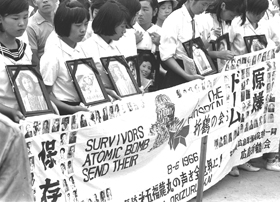
Decision to preserve the A-bomb Dome
1966 Nakajima-cho
In 1960, the “Hiroshima Paper Crane Club” was quick off the mark to promote preservation of the A-bomb Dome. On August 6, 1966, the “Determination Report on Preserving the A-bomb Dome—Memorial Gathering of Boys and Girls” was implemented.
Commencement of the first preservation project(Right)
1967 Ote-machi 1-chome
The first preservation project was carried out from April 10 to August 5. The construction costs of 51.5 million yen were fully covered by raised funds.
|
|
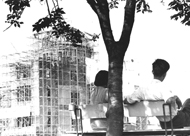
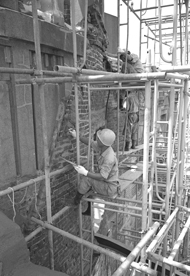
|
 |
 |
 |
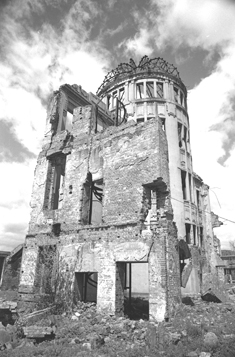
Prior to preservation
1967 Ote-machi 1-chome
Having been exposed to the weather, the dome was on the verge of collapse.
|
 |
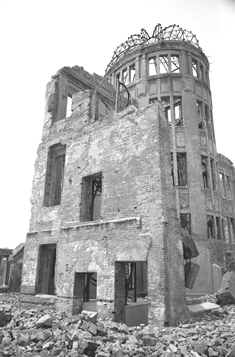
After preservation
1967 Ote-machi 1-chome
State-of-the-art technologies of those days were put to full use to maintain the damaged appearance after the A-bombing as much as possible and to keep the dome from collapsing.
|













